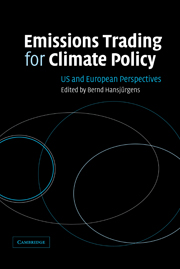Book contents
- Frontmatter
- Contents
- List of figures
- List of tables
- List of contributors
- Preface
- List of abbreviations
- 1 Introduction
- Part 1 Regulatory instruments for climate policy: theoretical aspects
- Part 2 The US approach to pollution control: lessons for climate policy
- 5 Implications of the US experience with market-based environment strategies for future climate policy
- 6 US experience with emissions trading: lessons for CO2 emissions trading
- 7 Climate change policy viewed from the USA and the role of intensity targets
- 8 Design issues of a domestic carbon emissions trading system in the USA
- Part 3 European policies to control greenhouse gases: the EU directive on emissions trading
- 14 Concluding observations
- Index
- References
5 - Implications of the US experience with market-based environment strategies for future climate policy
Published online by Cambridge University Press: 22 September 2009
- Frontmatter
- Contents
- List of figures
- List of tables
- List of contributors
- Preface
- List of abbreviations
- 1 Introduction
- Part 1 Regulatory instruments for climate policy: theoretical aspects
- Part 2 The US approach to pollution control: lessons for climate policy
- 5 Implications of the US experience with market-based environment strategies for future climate policy
- 6 US experience with emissions trading: lessons for CO2 emissions trading
- 7 Climate change policy viewed from the USA and the role of intensity targets
- 8 Design issues of a domestic carbon emissions trading system in the USA
- Part 3 European policies to control greenhouse gases: the EU directive on emissions trading
- 14 Concluding observations
- Index
- References
Summary
Introduction
Perspectives in the United States regarding potential public policies to address the threat of global climate change have developed over time within the context of domestic US environmental policies and public and private attitudes toward those policies. Over the past two decades, as market-based environmental policy instruments have been proposed and implemented in the United States, the concept of harnessing market forces to protect the environment has evolved from political anathema to being politically correct. In this chapter, I reflect on these experiences, and assess their implications for current considerations of potential domestic climate policies.
Environmental policies typically combine the identification of a goal with some means to achieve that goal. Although these two components are often linked within the political process, I focus here exclusively on the second component, the means – the “instruments” – of environmental policy. Market-based instruments are regulations that encourage behavior through market signals rather than through explicit directives regarding pollution control levels or methods. These policy instruments, such as tradable permits or pollution charges, can reasonably be described as “harnessing market forces,” because if they are well designed and implemented, they encourage firms or individuals to undertake pollution control efforts that are in their own interests and that collectively meet policy goals.
By way of contrast, conventional approaches to regulating the environment are often referred to as “command-and-control” regulations, since they allow relatively little flexibility in the means of achieving goals.
- Type
- Chapter
- Information
- Emissions Trading for Climate PolicyUS and European Perspectives, pp. 63 - 77Publisher: Cambridge University PressPrint publication year: 2005
References
- 4
- Cited by

